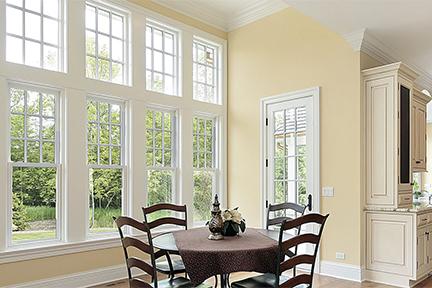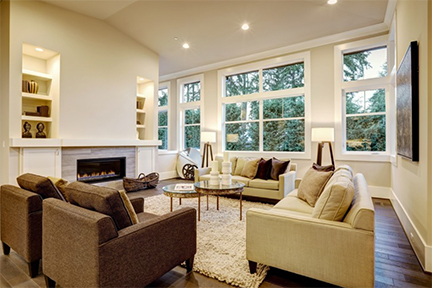
Selecting the right windows with saving energy functions for your home can significantly impact your energy bills, indoor comfort, and general environmental footprint. With numerous options available, it's essential to understand the key features that make apertures energy-efficient and how to identify them.
It is equally important to comprehend that adding energy-efficient window replacements to a home remodeling Lafayette project, for instance, can be made a lot easier with professional help. Certified fitters make sure that your windows are properly installed and sealed, which is very important for getting the most out of them and making sure they last a long time.
The Key Features of Energy-Saving Windows
Apertures that promote energy saving are designed with specific features that minimize heat transfer, improve insulation, and enhance overall performance. Here are the most important characteristics to look for:
Low-E Glass
Low-emissivity (Low-E) glass is a type of glass coated with a thin, transparent layer of metal oxide. This coating reflects infrared light, keeping heat inside during the winter and outside during the summer. Low-E glass also reduces UV light penetration, which helps prevent furniture and flooring from fading.
- Benefits: Reduces energy loss by 30 to 50%, improves indoor temperature regulation, and protects interior furnishings from UV damage.
- Considerations: Different types of Low-E coatings are available, such as hard-coat and soft-coat. Soft-coat Low-E glass generally offers better performance but is more expensive.
Double or Triple Glazing
Glazing refers to the number of glass panes in a window. A window with two panes of glass and a gap between them is called double-glazed. An aperture with three panes of glass is referred to as triple-glazed.
- Benefits: Multiple panes provide better insulation by creating air pockets that reduce heat transfer. When it comes to noise reduction and insulation, triple glazing outperforms double glazing.
- Considerations: Triple-glazed windows are more expensive and heavier, requiring stronger frames and potentially more substantial support structures.
Gas Fills
The space between the panes in double- or triple-glazed windows is often filled with inert gases like argon or krypton. These gases are denser than air, providing better thermal insulation.
- Benefits: Increases the window's insulating properties, reduces heat loss, and improves energy efficiency.
- Considerations: Argon is the most common and cost-effective option, while krypton offers slightly better performance at a higher cost.
Thermal Breaks
Thermal breaks are insulating materials placed between the interior and exterior parts of a window frame to reduce heat transfer. This feature is particularly important for aluminum frames, which conduct heat more readily than other materials.
- Benefits: Improves the overall insulation of the window frame, reduces condensation, and enhances energy efficiency.
- Considerations: Look for windows with well-designed thermal breaks, especially if you prefer metal frames for their strength and durability.
The Importance of ENERGY STAR Ratings
A government-backed symbol for energy efficiency, ENERGY STAR, provides simple, credible, and unbiased information that consumers and businesses rely on to make well-informed decisions. When shopping for energy-efficient windows, the ENERGY STAR label is an essential indicator of performance.
ENERGY STAR Labels
- U-Factor: Measures the window's ability to insulate. Lower U-factors indicate better insulation and greater energy efficiency. Aim for a U-factor of 0.30 or lower for optimal performance.

- Solar Heat Gain Coefficient (SHGC): Indicates how well the window blocks heat from sunlight. Lower SHGC values (0.25 to 0.40) are preferable for hot climates, while higher values are better for cold climates.
- Visible Transmittance (VT): Measures the amount of visible light that passes through the window. Higher VT values (0.50 to 0.70) are desirable for more natural light, but they should be balanced with the need for energy efficiency.
- Air Leakage (AL): Indicates the rate at which air passes through the window joints. Lower AL values (0.1 to 0.3) are better for minimizing drafts and improving energy efficiency.
Concluding Remarks
To choose energy-efficient windows for your home, you need to know about their different features and how they work together. You can make your home much more energy-saving and insulate it better by focusing on Low-E glass, double or triple windows, gas fills, and thermal breaks. Additionally, paying attention to ENERGY STAR scores can help you choose the apertures that will work best in your area and meet your needs.
Additionally, bear in mind that investing in professional installation ensures that your windows are installed correctly, maximizing their benefits and providing long-term value. Whether you're upgrading your current windows or planning a full home remodel, selecting the right energy-efficient windows can lead to substantial savings, improved comfort, and a reduced environmental footprint. If you're interested in further enhancing your home's sustainability, you can discover more innovative energy solutions to make your living space greener and more efficient.
For more detailed information, you can refer to resources provided by the US Department of Energy and ENERGY STAR.
